Home » Jazz Articles » Live Review » TD Toronto Jazz Festival 2010
TD Toronto Jazz Festival 2010
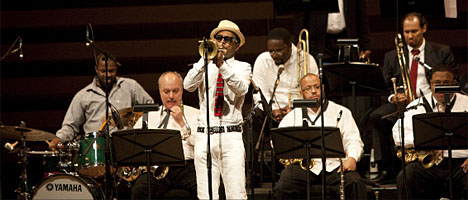
Toronto, Ontario, Canada
June 25-July 4, 2010
The TD Toronto Jazz Festival enjoyed its 24th edition this year in a city dominated by a focus on the G8 and G20 Summit meetings for the first few days. Despite very minor delays for a couple of shows and some instances of nearby protester clashes with law enforcement, the festival successfully managed to "go on with the show" without a hitch in the true spirit of jazz. It was also a fresh start for the new Artistic Director, Josh Grossman, who assumed his responsibilities in January of this year.
The festival continued its tradition of presenting a balanced program of major headliners such as Harry Connick, Jr., Herbie Hancock, Taj Mahal, and Stanley Clarke, as well as other key performers of different styles.
June 25: Maceo Parker
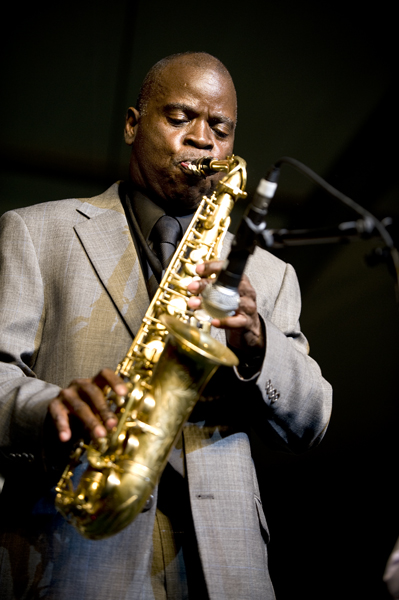 On opening night, youthful divas delivered great shows before their respective crowds: Nikki Yanofsky performed over at Koerner Hall, while Martha Wainwright, with her rendition of Edith Piaf's classics, sang at the Great Hall.
On opening night, youthful divas delivered great shows before their respective crowds: Nikki Yanofsky performed over at Koerner Hall, while Martha Wainwright, with her rendition of Edith Piaf's classics, sang at the Great Hall. For James Brown-style funk, the Mainstage Concert was the place to be. When Maceo Parker comes to town, his band brings the spirit, the professionalism, and the music to get people moving. Rodney "Skeet" Curtis was on bass, Bruno Speight on guitar, and Jamal Thomas on drums. The front horns accompanying Maceo were the fabulous Ron Tooley on trumpet and Dennis Rollins on trombone. Diehard jazz enthusiasts will remember Rollins performing at the now defunct IAJE jazz convention, as he attracted a lot of attention with his versatility on the instrument with additional sound effects.
Will Boulware added a rich musical touch to the keyboards that is not usually heard in other bands, while Corey Parker—Maceo's son—and Neta Hall provided the central vocal component to the show. The Maceo Parker band went right into the spirit of things with "Off The Hook."
Music selections came from older recordings, including "Make It Funky," "What You Know about Funk?," and "Shake Everything You've Got," from Life on Planet Groove(Polygram Records , 1992). The classic "Uptown Up," from Funk Overload (What Are Records, 1998), always gets people energized thanks to the wonderful sound of the horns playing in unison with some cool accentuation from Rollins. Later in the show, Maceo stood alone on stage and paid homage to Ray Charles with his rendition of "You Don't Know Me."
Near the end of the show, everyone was on their feet (mostly dancing), without needing any prodding from the band as they yelled out "Maceo! Maceo!" for an encore with the classic James Brown favorite, "Pass the Peas."
The band members were clearly enjoying themselves; the syncopation and timing were right on the mark, with each musician receiving the opportunity to shine. Before you knew it, the concert was over in the late hours of the festival's kickoff night.
June 27: David Sanborn with Joey DeFrancesco
David Sanborn's highly anticipated performance finally made it to the TD Toronto Jazz Festival at the beautiful Koerner Hall, together with Joey DeFrancesco, whom the altoist calls the monarch of the B3, and drummer Gene Lake. How fitting to have these musicians playing selections from both Only Everything (Decca, 2010) and Here And Gone (Decca, 2008), both tributes to Ray Charles. It was only after hearing Charles that Sanborn decided to pick up the saxophone, as the late pianist/singer was a great alto player in addition to being a master of the Hammond B3. This was essentially a true Chicago trio on display, with blues being the name of the game.
After kicking things off with a fast "Coming Home Early," featuring the alto saxophonist's signature sound, the trio brought things down a bit with "Brother Ray," after which Sanborn jokingly asked the audience, "How's the weekend going?"
To Sanborn, the saxophone is very close to the human voice and he credits both Hank Crawford and David "Fathead" Newman as major influences. In recognition of these influences, he played "The Peeper," a Crawford arrangement that has always stuck with Sanborn. The fun blues tune included energetic vibrato snippets that nicely welcomed song references.
The trio continued with the popular "Let The Good Times Roll," with DeFrancesco providing the vocal touch and inviting the crowd to clap with the beat as Lake set up the musical sandbox, making Dave and Joey sound their best.
"Only Everything" had the feel of a timeless soul ballad, written for Sanborn's granddaughter, Genevieve. DeFrancesco emphasized the organ's warm and earthy sounds with a hint of strings. At one point he picked up a muted trumpet in his right hand for a solo in the style of Miles Davis, while playing chords with his left hand on the organ.
For the encore, Sanborn talked about someone he knows who always makes bad choices when it came to relationships. He looked towards DeFrancesco but eventually claimed that he didn't mean to refer to anyone in the band, much to the organist's relief. "I Got News for You" was that final song, with DeFrancesco once again demonstrating his vocal talents, even after missing the first queue.
June 29: Grace Kelly Quintet
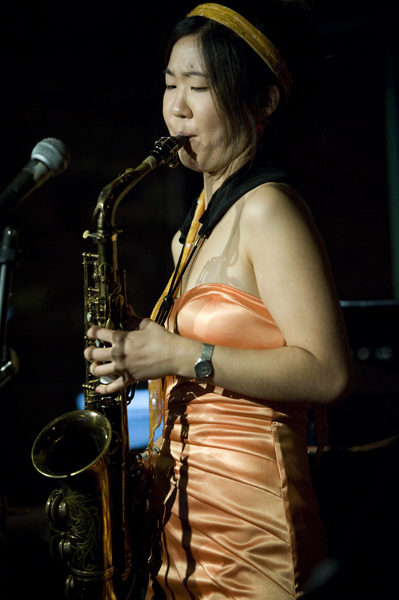 On Tuesday evening, festival visitors had an eclectic choice of musical possibilities. At Koerner Hall, Dave Brubeck returned for his current touch on some of his all-time classics. American hip hop band and the house band for The Jim Fallon Show, The Root}, presented an energetic show on the Mainstage. Over at The Trane Studio, Grace Kelly took the spotlight and amazed those who encountered her for the first time, having played last year at The Rex, as well as the Orangeville Blues and Jazz Festival, just north of Toronto. Labeled a child prodigy by jazz greats, this alto saxophonist, singer, composer, and arranger still maintains her youthful zest at the age of 18. Having picked up the sax at 10, she has already mastered techniques that can take years to accomplish.
On Tuesday evening, festival visitors had an eclectic choice of musical possibilities. At Koerner Hall, Dave Brubeck returned for his current touch on some of his all-time classics. American hip hop band and the house band for The Jim Fallon Show, The Root}, presented an energetic show on the Mainstage. Over at The Trane Studio, Grace Kelly took the spotlight and amazed those who encountered her for the first time, having played last year at The Rex, as well as the Orangeville Blues and Jazz Festival, just north of Toronto. Labeled a child prodigy by jazz greats, this alto saxophonist, singer, composer, and arranger still maintains her youthful zest at the age of 18. Having picked up the sax at 10, she has already mastered techniques that can take years to accomplish.On the opening "Ain't No Sunshine," by Bill Withers, Kelly brought a gentleness to her sound and phrasing in what she called a slightly twisted version of the well-known song. Her vocal abilities were also on full display with "Straighten Up and Fly Right," by Nat King Cole, where she managed to weave in some truly improvised lyrics; talking, for example, about which city she was in and where she was going next. "Happy Theme Song" was an original composition that truly represented Kelly and some of her musical influences; bubbly and bright, with a distinctive Charlie Parker sound. The piece also featured trumpeter Jason Palmeri, who came onstage to complete the quintet. The set ended with an extended rendition of "Caravan," combining tempo changes and top of the horn harmonics, culminating in an imaginative solo by Palmeri that included a brief Raiders of the Lost Ark reference.
Kelly was comfortable onstage, as well as with the audience. She, after all, has had the opportunity to play in the company of major musicians and bands like the Lincoln Center Jazz Orchestra with Wynton Marsalis. Her traveling band, as a whole, is very organic. Kelly was more than happy to share the stage with them and let them shine.
June 30: Keith Jarrett Trio
The Tuesday before the long Canada Day weekend presented a wide variety of performances for their enjoyment. Mavis Staples and the Allen Toussaint occupied the Toronto Star stage, while Charlie Hunter played just a few blocks away at the Hard Rock Café. Vocal fans could choose from either the Russ Little Quintet and Heather Bambrick, featuring Carol Welsman, or the Roberta Gambarini. James Farm featuring Joshua Redman and others performed at the Enwave Theatre at Harbourfront.
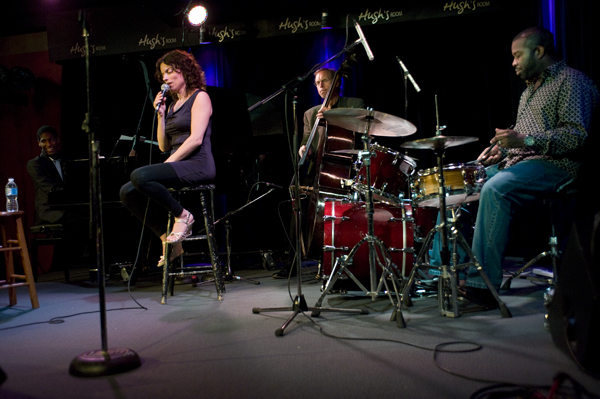 Roberta Gambarini
Roberta GambariniThe Keith Jarrett returned to the festival three years after inaugurating the Grandmasters Series at the Four Seasons Centre. The location was ideal for a group of this caliber, free from the distractions of an open air context. The packed auditorium was ready to enjoy two sets of pure music. In a past interview, Jarrett admitted that a jazz musician should perform as if it might be the last time, and not play as if there is all the time in the world. A player must be faster than his insecurity when facing audience expectations, as an "audience may have the wrong impression of what you are about to play." This philosophy was very evident from the evening's performance, and demonstrated the joys of a musical relationship that is as fresh as ever. A Keith Jarrett Trio performance is always a special event, especially if it's in a pin-drop sensitive hall, with the audience hanging on every note.
The whole trio played softly in a tight unit, as expected after working together for over 25 years. Gary Peacock showcased varied bass riffs appropriately, with Jack DeJohnette using just the right touch to balance his drums and cymbals, as well as with his brushes. Both musicians provided the ideal counterpoint to Jarrett's harmonic permutations and phrasing. The sound was well balanced, whether the trio played an easy-tempo rendition of Jerome Kern's "Yesterdays" or a lightly swinging blues, such as Ornette Coleman's "When Will The Blues Leave."
At times hunching over the piano keys or standing, Jarrett took great care at playing and savoring every note to perfection. Right before intermission, he was short of satisfied with the sound of a particular note, and even asked the audience, "Does this sound okay?" Predictably the crowd said yes. Nevertheless, Jarrett switched gears to play the sentimental "Blame It On My Youth," a jazz standard written by Oscar Levant and Edward Heyman. During the intermission, a second piano was hauled in discreetly. Nothing affected the positive mood of the musical evening. The meticulous notes during quieter moments felt like delicate leaves or light raindrops reaching the ground, with the audience quietly savoring every one. Jarrett nodded after each tune in appreciation of the receptive audience and in the acknowledgment that the trio was in top form. The smiles among the musicians showed just how much they enjoyed their improvisational journey over melodies that they knew very well. The audience gave them a well-deserved standing ovation, and was rewarded with three encores, starting with "God Bless The Child," followed by "Answer Me My Love," popularized by Nat King Cole in the 1950s, and ending with "Bye Bye Blackbird." A truly special evening.
July 1: Roy Hargrove Big Band
It is not always easy to get a big band together, let alone to go on tour with it. True to the jazz idiom, Roy Hargrove embarked on a straight-ahead project entitled Emergence (Emarcy, 2009), and the band has had the opportunity to tour; a challenge at the best of times. Toronto jazz fans have had the opportunituy to see him over the years in different contexts, ranging from the Crisol band and his RH Factor to being a member of the Dizzy Gillespie All-Star band. It's almost as if Hargrove is continuing the Gillespie band tradition, a sense supported by his onstage persona during "September In The Rain," where he showcased his own vocal talents as well as drawing on the familiar call-and-response routine, with the band repeating his scats.
There was also a good dose of Gerald Wilson, who also commands major bands with a full sound. It was nice to see this 19-piece band following these traditions at Koerner Hall, also featuring Roberta Gambarini, who performed earlier in the week in Hugh's Room and who also sang on Hargrove's recent album. Gerald Clayton, who was on the original recording, was replaced by the very talented Jonathan Baptiste. The show lasted two full hours, without an intermission, as the band had to hit the road early the next morning.
Hargrove came onstage sporting a white shirt, pants and hat, with a red tie and cool shades as the band kicked off with "Tschpiso," followed quickly by "Depth" and "After The Morning" by John Hicks, one of Hargrove's mentors.
Hargrove was also very generous with the stage, and most musicians were featured. Altois Bruce Williams and trombonist Vincent Chandler both had very expressive solo features during "Requiem." Gambarini provided a vocal change of pace with songs including "La Puerta," "Everytime We Say Goodbye" and "Something Happens," her voice supportive between choruses but, at times, muffled by the sheer power of the band.
What better choice to end the show than with the catchy "Mambo For Roy," a dedication from Cuban pianist Chucho Valdés, showcasing various Latin twists and powerful horn runs. The show's encore ended with "Brian's Bounce," accompanied by Gambarini. All in all, the audience came away with a good dose of big band swing, Latin expressiveness and energy, as well as some romantic tranquility during key ballads.
July 2: John Scofield and The Piety Street Band
On a beautiful day in July, festival visitors enjoyed the final stretch of this year's edition of the TD Toronto Jazz Festival. During lunchtime at Nathan Phillips Square, the Monterey Jazz Festival showcased its Next Generation Orchestra, with wonderful young talents, while the afternoon drew to a close with Yvette Tollar and her quintet.
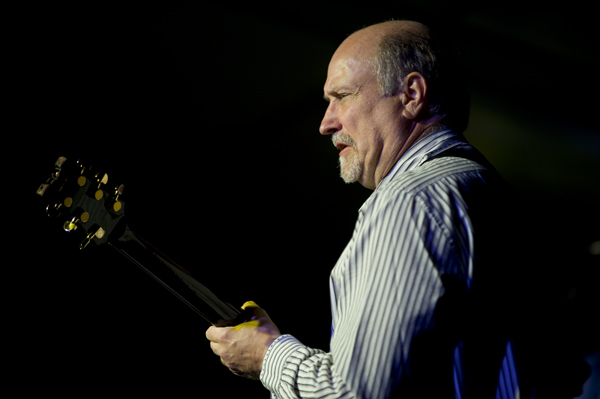 John Scofield
John ScofieldThe final Mainstage concert placed the focus on gospel, blues, jazz and R&B, with Toronto-based singer Shakura S'Aida opening up the evening with a charismatic performance that warmed the audience up. A frequent visitor to the festival over the years, guitarist John Scofield returned for the main event in this double-bill with his most recent project, Piety Street (Emarcy, 2009), connoting the gospel nature and context of this band. Originally, Scofield wanted to do a blues album, but opted to have some fun interpreting a few old gospel tunes with his own spin. Many would see this as a natural progression for him, and opening the show with "That's Enough," it was clear that all the elements were in place.
Jon Cleary provided most of the lead vocals, yet the main focus was always on the music, with Scofield playing fast blues riffs while standing to the right and facing into the rest of the band. Pieces like "Let The Good Times Roll" were easily recognizable, while "Walk With Me" was a slower gospel piece that despite being old, according to Scofield, made its way into other more well-known songs, written with the same chord progression. Scofield started improvising discreetly around the melody, alone on the stage, before being joined by the rest of the crew. Bassist George Porter Jr. showcased some head-boppin' deep grooves as he opened "Never Turn Back.
The climactic piece was the upbeat, gospel-driven 12-bar blues, "It's a Big Army," with Cleary playing the organ with his right hand while saving his left for the piano. Despite the engaging rhythm, no dancing took place, but drummer Terrence Higgins got the audience to participate in some clapping, shifting to a tambourine/bass drum solo dominated by African beats that were quintessentially New Orleans in style. The band also managed a subtle nod to "When the Saints Go Marchin' In" in the final chorus. The encore was just as eventful; on "I Don't Need No Doctor," Scofield and Cleary (switching to guitar) trading off at one point. Scofield displayed different elements from gospel, blues and funk to jazz and R&B in a show that demonstrated the importance of experiencing such performances live.
July 3: Doran—Stucky—Studer & Tacuma Play Music of Jimi Hendrix
On the festival's final day, jazz enthusiasts still had a few shows to choose from around town. A large gathering formed early at Dundas Square to see Chaka Khan and Macy Gray. Just around the corner, trumpeter Christian Scott aTunde Adjuah was the star at the Hard Rock Café, while Andy Milne & Dapp Theory performed two sets at the Trane Studio.
Over at the Music Gallery in the quaint St. George The Martyr Church, the Next Wave Series concluded its short eclectic week of avant-garde artists. It was an opportunity to get a different taste of the festival, away from the masses standing at Dundas Square for the headlining pop show. Intensity and loudness would be two key words setting off the opening salvos for Doran, Stucky, Studer and Tacuma. The group revisited the art of the legendary Jimi Hendrix after the NKLS Quartet opened up the show for the evening. Improvisation and lyrics are part of the Hendrix universe that these musicians showcased, without ever trying to mimic the late guitar icon.
Ericka Stucky interpreted some of Hendrix's songs while setting the mood as the de facto leader in front of the band. She made use of simple objects ranging from garden tools and voice altering gadgets to handheld audio recordings. Christy Doran focused solely on his guitar playing, including some intense guitar wizardry with the aid of echoing sound effects. Such was a glimpse into the frame of mind existing in the 1960s. Stucky urged the audience to open up to the music and "just let go," even warning them that since the music was loud, their ears might be ringing. Thank goodness for earplugs.
On "Isabella," Doran admitted that he and others discovered interesting polyrhythmic structures leading to the thought of playing three grooves on top of each other. Audience members were literally calling out requests for the encores. Stucky first led a duet with Doran alone, and the whole band came together for its rendition of "Castles Made Of Sand." Still, after just a short one-hour set, there was still more time to hear some other music around town.
Pianist Geoffrey Keezer played on two separate evenings at Tthe Rex, a key Toronto jazz hangout; once with a trio and, on the final night, with the Toronto Jazz Orchestra led by the festival's Artistic Director.
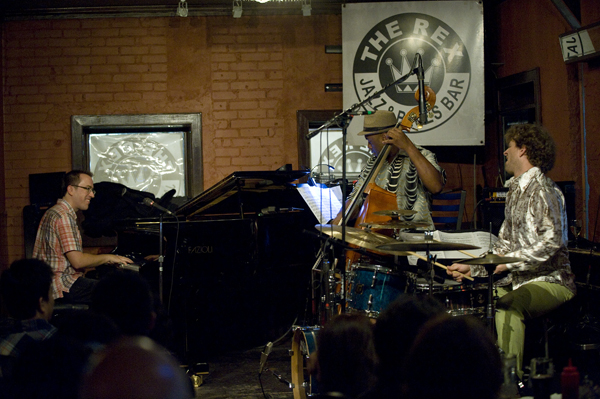 Geoffrey Keezer
Geoffrey Keezer2011 will be the festival's 25th edition. With anticipated renovation work planned for Nathan Philipps Square, festival organizers will be evaluating various location options following the postmortem on this year's event. Milestone years always bring a certain level of anticipation and buzz, and 2011 will be no exception.
Photo Credit:
Marek Lazarski
< Previous
Cheap Trick and Squeeze At Radio City...
Next >
Trio
Comments
Tags
Toronto Jazz Festival
Live Reviews
Alain Londes
Canada
Harry Connick Jr
Herbie Hancock
Taj Mahal
Stanley Clarke
Nikki Yanofsky
James Brown
Maceo Parker
Dennis Rollins
Ray Charles
David Sanborn
Joey DeFrancesco
Hank Crawford
David "Fathead" Newman
Miles Davis
Dave Brubeck
grace kelly
Nat "King" Cole
Charlie Parker
wynton marsalis
Allen Toussaint Band
Charlie Hunter
Heather Bambrick
Carol Welsman
Roberta Gambarini Quartet
James Farm
Joshua Redman
Keith Jarrett Trio
Gary Peacock
Jack DeJohnette
Ornette Coleman
Roy Hargrove
Dizzy Gillespie
Gerald Wilson
Roberta Gambarini
Gerald Clayton
Bruce Williams
John Scofield
CHRISTIAN SCOTT
Jimi Hendrix
Geoffrey Keezer
For the Love of Jazz
 All About Jazz has been a pillar of jazz since 1995, championing it as an art form and, more importantly, supporting the musicians who create it. Our enduring commitment has made "AAJ" one of the most culturally important websites of its kind, read by hundreds of thousands of fans, musicians and industry figures every month.
All About Jazz has been a pillar of jazz since 1995, championing it as an art form and, more importantly, supporting the musicians who create it. Our enduring commitment has made "AAJ" one of the most culturally important websites of its kind, read by hundreds of thousands of fans, musicians and industry figures every month.





















